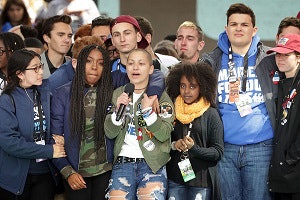Emma González is getting to know some of the people who knew about her before she arrived on the campus of the New College of Florida this semester.
The freshman rose to national prominence earlier this year as one of the students who became a vocal advocate of gun control following the deaths of 17 of her classmates and staff in February at Marjorie Stoneman Douglas High School in Parkland, Fla.
 Emma González, a Marjorie Stoneman Douglas High School graduate, speaks at the March for Our Lives event in D.C. in March a month after the mass shooting occurred.
Emma González, a Marjorie Stoneman Douglas High School graduate, speaks at the March for Our Lives event in D.C. in March a month after the mass shooting occurred.In her first weeks on campus, she has found the New College community to be very accepting and classmates to be “kind and understanding.”
“A lot of people here feel like it’s weird that they know about me without me having gotten to know about them,” says González. “So they generally have just been like, ‘Hi, I’m so and so, I’m really inspired by what you’ve done. Also I’m majoring in this, what about you?’ so that it’s not awkward for me, either.”
And regardless of how someone feels about the issue of guns on school property, she says, “having calm and level-headed discussions with people who disagree with you is a very good way to show them that it’s a subject you care about without getting rude or profane.”
The issue of guns on college campuses looms large as differing groups seek to find a balance between First Amendment free speech rights and the Second Amendment right to bear arms.
There have been more than 30 shootings occurring on school properties in the U.S. so far in 2018, from the Marjory Stoneman Douglas High School shooting in February to the Santa Fe High School shooting in May, where individuals have used firearms such as shotguns and AR-15’s during shootings.
After the Parkland shooting, many students channeled their anger and grief into advocacy for gun control and legislative reform, sparking a #NeverAgain revolution amongst Generation Z. Many of those students have graduated high school with some deciding to attend college, continue their activism for gun safety or choose another path.
González is looking forward to taking up the issue, along with academics, as she embarks on the college journey.
“The classes I’m taking are about politics and environmental studies and I’m really enjoying learning through the college lens as opposed to the high school lens,” she told Diverse. “We have a great police team that’s very personable with the students and faculty on campus and are very good at keeping us safe.”
Opponents of conceal carry on campuses contend that it could have a chilling effect on free and open dialogue and would make campuses less safe. Proponents argue that those carrying concealed weapons could help bring a mass shooting incident to an end more quickly.
 Peter F. Lake
Peter F. LakeThis semester, 313 higher ed institutions have issued statements that students on their campuses will not be disciplined for peacefully demonstrating for gun control, according to NeverAgainColleges.com.
A federal appeals court in Texas recently dealt a blow to three University of Texas at Austin professors who challenged the state’s campus-carry law, Senate Bill 11, which was enacted in 2015 and allows concealed guns in classrooms. The American Association of University Professors was among supporters of the plaintiffs, but the court ruled that the argument that the policy would have a chilling effect on freedom of speech was not valid absent the certainty that violence would take place on campus as a result of it.
The Texas ruling is the latest in several cases where courts have struck down bans or attempted bans on carrying concealed weapons on college campuses. The Oregon Court of Appeals overturned the Oregon University System’s ban in 2011 and the University of Colorado lost in a Colorado Supreme Court ruling in 2012, with judges in both cases ruling that the schools had overreached their authority because only the state legislature can regulate the possession of guns.
Jimmy Johnson, assistant vice president of campus safety at UT-Austin, said that as a result of Texas being a majority Republican state, “those types of politics played a part into how this law got passed and in turn how that got implemented on college campuses. But I think that a very open-minded conceptual process was taking place here on campus that put in some very solid policies that protected interests on both sides.”
Strong opposition to the law has been present among faculty and students. One organization, Cocks Not Glocks, was founded by UT-Austin alumna Jessica Jin after the law was enacted in 2015. The group, not recognized as an official university organization, has an all-female leadership team that “fights absurdity with absurdity” – displaying dildos as part of their protest of the campus-carry law.
“We organized the protest in response to the state law that was being enacted that summer that started allowing students to conceal carry on campus,” said Jin. “And since then we’ve all continued to work on the issue from different angles” such as volunteering on political campaign and voter registration initiatives.
Johnson also noted that the only instance where a Texas licensed gun owner cannot carry a concealed handgun is when the location is a polling place for any type of election.
“We have several buildings on campus that do that. During the rest of the year, they don’t fall into that prohibited category, but they do on the days that polling is taking place,” said Johnson. “But by the statutory law, all that has to be present is a sign that says ‘voting here.’”
 Dr. Lynn Pasquerella
Dr. Lynn PasquerellaAccording to UT-Austin’s statistics, Johnson said, roughly between 1 and 2 percent of students could be carrying a concealed gun on campus. The rest of the group present on campus with concealed-carry licenses is estimated to be between 5 and 10 percent, he says.
Other states with laws that allow concealed weapons to be carried on public post-secondary properties are Arkansas, Georgia, Idaho, Kansas, Utah and Wisconsin. Tennessee’s allowance differs in that permission is granted to faculty members and not students or the public.
On the other hand, 16 states ban carrying a gun on a college campus: California, Florida, Illinois, Louisiana, Massachusetts, Michigan, Missouri, Nebraska, Nevada, New Jersey, New Mexico, New York, North Carolina, North Dakota, South Carolina and Wyoming.
About half of states – 23 – give colleges the latitude to make their own individual choices: Alabama, Alaska, Arizona, Connecticut, Delaware, Hawaii, Indiana, Iowa, Kentucky, Maine, Maryland, Minnesota, Montana, New Hampshire, Ohio, Oklahoma, Pennsylvania, Rhode Island, South Dakota, Vermont, Virginia, Washington and West Virginia.
The differences demonstrate how the issue of gun control is very much a local one, says Peter F. Lake, director of the Center for Excellence in Higher Education Law and Policy at the Stetson University College of Law in Florida.
“When it comes to college carry laws, what you tend to see is state- and locality-specific approaches,” he says. “It turns a lot on the weapons culture in the local place you’re talking about.”
He recalled the time in the 1980s when he entered a fine restaurant in Dallas and found that diners could check their firearms at the door – something he never experienced growing up in Boston.
Lake and Dr. Lynn Pasquerella, president of the Association of American Colleges and Universities (AACU), agreed that the issue has deeper cultural roots.
“There’s an awful lot of conflict in American society now, and lots of people at the margins of society have chosen to arm themselves and do damage to others,” says Lake. “I don’t think that any one national government entity could alter the landscape with one stroke of a pen. This is a culturally embedded phenomenon.
“We’ve got a broader social issue bout dealing with mental health, conflict resolution and how people perceive others, areas people aren’t spending as much energy on now,” he adds. “Behind every gun violence situation is the possibility of a preventative step that humans can take. Whatever is troubling people, we have to get to these root causes.”
The AACU has independently and collaboratively taken positions in recent years to encourage lawmakers to “really dial back” on campus carry laws that it sees as infringing on academic freedom and freedom of expression, as well as closing legal loopholes and expanding background checks to make it more difficult for dangerous people to obtain firearms, says Pasquerella.
At the same time, she says there’s a need to address how the mentally ill, violence-prone and “people underserved by society continue to have access to guns” —and how issues of race, gender and class affect groups on campuses and inform campus-carry laws and other gun legislation.
Noting the recent rise of student gun-control activists, Pasquerella says she hopes they “will continue to fight for racial and social justice in relation to gun laws.”
On other sides are groups such as the national nonpartisan Students for Concealed Carry on Campus and the NRA Collegiate Coalition.
Current debates about gun rights and control are at a place where various perspectives are unlikely to all see eye-to-eye, partly because “global cross-fertilization” has made the issue more culturally complex and nuanced, says Lake.
“I don’t think the debate is going to resolve itself quickly,” he says. “And I don’t think it will be the same everywhere. It’s where we are, and I think it’s where we’re going to be for a period of time to come.”
LaMont Jones can be reached at [email protected]. You can follow him on Twitter @DrLaMontJones. Monica Levitan can be reached at [email protected]. You can follow her on Twitter @monlevy_.





















